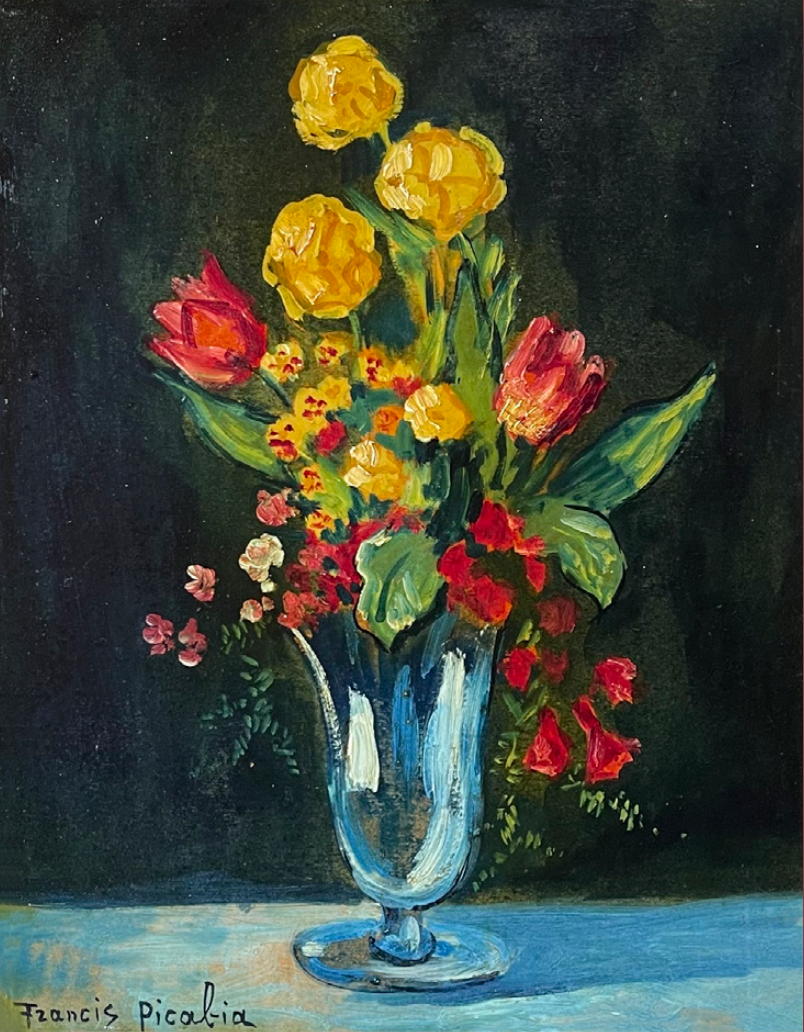FRANCIS PICABIA - FLOWERS IN A VASE
FRANCIS PICABIA - FLOWERS IN A VASE
FRANCIS PICABIA
1879-1953
Fleurs Dans Un Vase
Flowers in a Vase
Signed
Oil on cardboard
48 x 39.4 cm
Price is available upon request.
Provenance:
The artist was painted by Jarman in 1920
taken from him
Me Baussy Cannes 11 October 1972 Auction
By the grandfather of the previous owner
purchased from the above auction and inherited
was transferred to him through
Portakal Art Culture and Auction House
“The Great Master of Western Painting from Monet to Picasso”
Masters” 16-28 February 2010
FA & YA Collection Istanbul 2010
Exhibition:
Portakal Art Culture and Auction House
“The Great Master of Western Painting from Monet to Picasso”
“Masters” 16-28 February 2010 Exhibition catalogue p.99
FRANCIS PICABIA 1879-1953
Francis Picabia’s career is defined by his diverse activities as a painter, poet, editor and pioneer of the international avant-garde. Born in Paris into a wealthy Spanish-French family, Picabia immersed himself in the most extreme currents of modern art from a young age. In 1902, he met the Impressionist Camille Pissarro and produced landscapes under the influence of the older painter, before moving on to Cubism and Dada. Picabia was included by the poet Guillaume Apollinaire as a representative of the subgenre of Cubism he called “Orphism” in his important book The Cubist Painters, Aesthetic Meditations (1913). During these years, Picabia produced large-scale works that pushed the pictorial language of Cubism towards abstraction. However, Picabia is remembered today primarily as the most controversial representative of the international Dada movement. From 1917 to 1924, Picabia edited the magazine 391, an ironic reference to Alfred Stieglitz's magazine and gallery 291, in which he published works by Dadaists such as Tristan Tzara, Marcel Duchamp, Céline Arnaud, and André Breton, as well as his own nihilistic poetry and "mechanomorphic" drawings. At various points in his life, Picabia supported himself through his dealings in the art market, focusing particularly on the buying and selling of works by other avant-garde artists. Despite the outrage he directed at Cubist art in the Dada manifestos, he acquired important Cubist examples throughout his career as an art dealer. Before 1914, he purchased Picasso's newspaper collage "Bottle and Goblet on the Table" (1912; The Metropolitan Museum of Art) from the Galerie Kahnweiler. Picabia subsequently sold the work to Alfred Stieglitz in New York for $150 in 1915 while serving in the French Army. Picabia later deserted the army and spent the war years in New York and later Barcelona, spreading the gospel of modernism internationally through various publications and exhibitions. Tzara recalls that Picabia was one of the buyers in the famous Kahnweiler confiscation sales from 1921 to 1923, when works by Picasso, Georges Braque, Juan Gris and Fernand Léger were sold after they had been confiscated by the French government during World War I.
Picabia’s activities in the art market were never entirely speculative, and he used his financial independence to finance exhibitions and publications for other young modern artists. Indeed, Juan Gris’s painting “Houses in Paris, Place Ravignan” (1911–12; Leonard A. Lauder Cubist Collection) bears witness to the close relationship between Gris and Picabia, and to Picabia’s place in the broader Cubist movement. In the lower left corner of the painting, signed in brown by Gris, “A mon cher ami Picabia/ avec toute l'admiration de/Juan Gris” (To my dear friend Picabia, with all my admiration, Juan Gris). Gris presented the painting to Picabia as a thank you for his inclusion in the Salon de la Section d’Or exhibition, which the artist had financed and which took place at the Galerie la Boétie in Paris from 10–30 October 1912. The exhibition was one of the most important European modern art exhibitions of the pre-war years, and showcased developments in Cubist painting. Indeed, through this exhibition and other Section d'Or exhibitions, the term "Cubism" had gained public currency by 1912, and was associated with artists such as Gris, Picabia, Jean Metzinger, and Albert Gleizes, to whom Picasso and Braque had not joined. From the 1920s until his death in 1953, Picabia's art and life underwent many dramatic changes, from figurative painting to abstraction and back again, to name a few, and this was a fitting circumstance for the most protean member of the avant-garde.
Share


